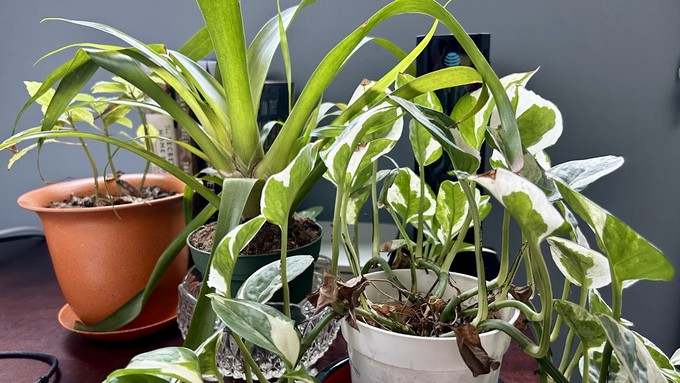
Time to show your indoor garden some love

These houseplants are thriving in the indirect light from a north-facing window. Kathy Morrison
It’s time to show some TLC to our indoor gardens. Why? Jan. 10 is National Houseplant Appreciation Day.
Our assortment of ferns, orchids and other tropical plants do more than decorate our rooms. They help keep us people healthier and happier.
The plants that make the best houseplants like the same conditions we do – temperatures in the 60s or 70s with bright in-direct light. They don’t ask much – weekly watering, a little fertilizer and an occasional dusting. In return, they offer a lot of positives.
Their foliage helps clean the air, filtering out pollutants and carbon dioxide while adding a little extra oxygen. In addition, houseplants contribute a little moisture and extra humidity to our indoor air, creating a more comfortable and cooler environment – for them and us.
Besides improving air quality, houseplants also have a therapeutic quality. We enjoy being around plants. They make us smile. They improve attitudes in both office and at home.
This day of recognition is credited to the Gardener’s Network (www.gardenersnet.com), which has been publishing an online gardening e-zine for 24 years. Nurseries and garden clubs spread recognition of this plant-centric commemoration.
Headquartered in Rochester, N.Y., the Gardener’s Network saw Houseplant Appreciation Day as a way snowbound gardeners could get their hands dirty in midwinter. Jan. 10 was chosen because it was after the holidays, likely after the exit of the Christmas tree.
Houseplants have never been more popular. With people stuck at home, the Covid-19 pandemic launched houseplant mania nationwide. Almost four years later, houseplant sales remain strong as people discovered they love their indoor jungles.
Low-maintenance plants are the best-sellers. That includes ZZ Plant (Zamioculcas zamiifolia), pothos and philodendron – especially variegated varieties. Also popular are indoor bloomers such as hoyas, moth and dendrobium orchids, anthuriums and dwarf bird of paradise.
Among the most efficient plants at cleaning air and improving air quality are peace lilies (Spathiphyllum).
How to celebrate Houseplant Appreciation Day?
* Start by checking soil moisture. Make sure your houseplants are well watered.
* Snip off dead foliage and show your plants some TLC.
* Dust the leaves; that helps the foliage function better.
* If possible, put your plants in the shower and give them a gentle indoor rain. That washes off dirt and grime that may have accumulated.
* Start some cuttings from your houseplants and share with friends.
* Get some more houseplants. The selection has never been better as more people discover the joy of indoor gardening. Find a new favorite or rediscover an old-time charmer.
For more advice on houseplants: https://www.gardenersnet.com/hplants/index.htm.
Comments
0 comments have been posted.Sacramento Digs Gardening to your inbox.
Sites We Like
Garden Checklist for week of July 21
Your garden needs you!
* Keep your vegetable garden watered, mulched and weeded. Water before 8 a.m. to reduce the chance of fungal infection and to conserve moisture.
* Feed vegetable plants bone meal, rock phosphate or other fertilizers high in phosphate to stimulate more blooms and fruiting. (But wait until daily high temperatures drop out of the 100s.)
* Don’t let tomatoes wilt or dry out completely. Give tomatoes a deep watering two to three times a week.
* Harvest vegetables promptly to encourage plants to produce more. Squash especially tends to grow rapidly in hot weather. Keep an eye on zucchini.
* Pinch back chrysanthemums for bushy plants and more flowers in September.
* Remove spent flowers from roses, daylilies and other bloomers as they finish flowering.
* Pinch off blooms from basil so the plant will grow more leaves.
* Cut back lavender after flowering to promote a second bloom.
* It's not too late to add a splash of color. Plant petunias, snapdragons, zinnias and marigolds.
* From seed, plant corn, pumpkins, radishes, winter squash and sunflowers.